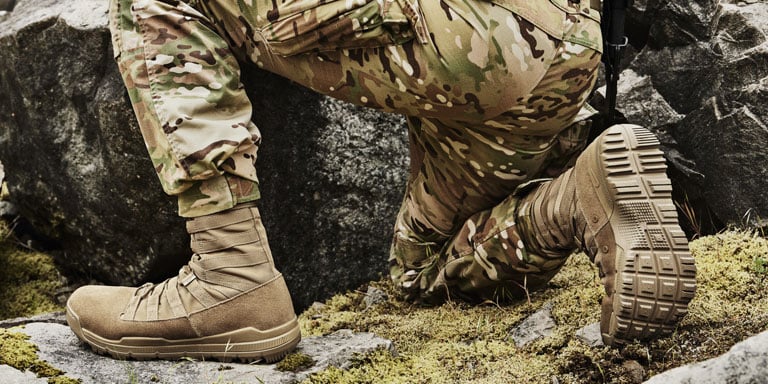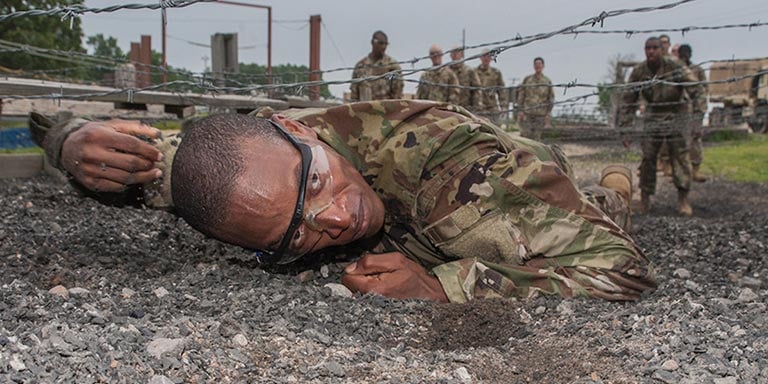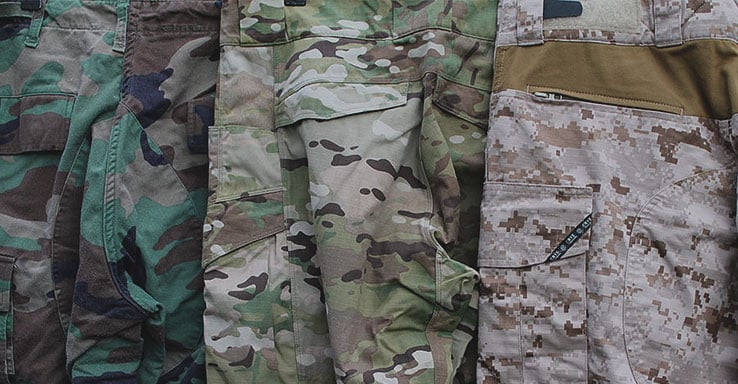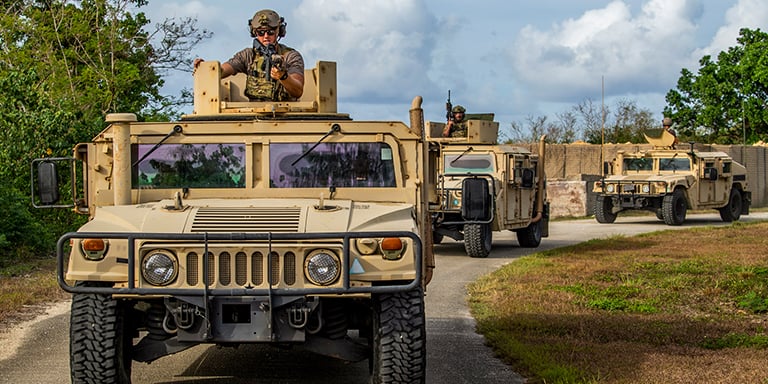
At first glance, a military convoy may appear simply to be a line of vehicles, but it's much more than that. Like many other things in the military, a convoy is precisely organized and takes skill and coordination to operate. It will reach its destination safely and on time only if all of its members perform their jobs well.
In this guide, we'll review the structure of a convoy, common formations, communications, and tactical combat considerations. We'll also briefly review how to navigate through or around various obstacles.
Elements of a Military Convoy
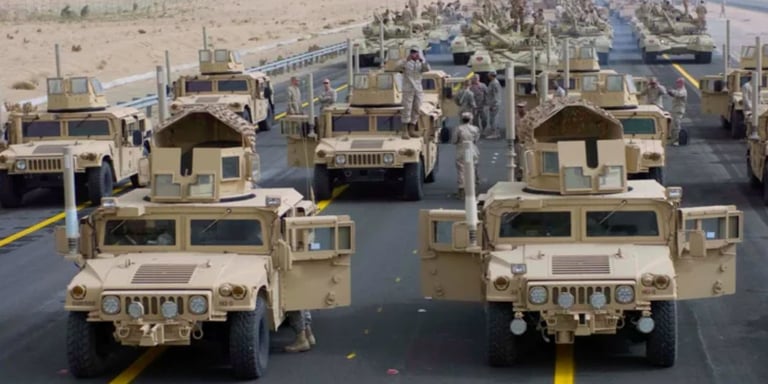
If you've been in the military for at least a few months, then you know (or at least suspect) that a convoy is more logistically complex than it seems to a casual observer. There are two broad categories of convoy elements: organizational and functional elements. Each consists of several other categories of unit or vehicle types.
Organizational Elements
The organizational elements of a convoy group vehicles by reference to a clear chain of command so that each element can communicate effectively and coordinate actions quickly. All convoys, regardless of size or mission, have the same three organizational elements. A convoy commander supervises the convoy as a whole and has operational authority over all personnel in it.
March Units
The smallest organizational element is the march unit, which typically consists of 2-20 vehicles. Exceptionally large convoys may have larger march units. Each march unit is overseen by a march unit commander.
Serials
A serial is a group of march units, generally no more than five. The serial consists of all the march units which are moving from the same point of origin to the same destination via the same route at the same time. This is an important distinction because large convoys may be composed of several distinct “mini-convoys,” and different parts of the convoy may take different routes or stagger their travel for tactical purposes. Each serial is overseen by a serial commander.
March Columns
A march column is a group of 2-5 serials and represents a battalion or brigade-sized element. A column commander oversees each one.
Functional Elements
A convoy's functional elements classify its vehicles and personnel according to their purpose and role in the mission. Each vehicle in the convoy falls into one of four such categories.
- The head vehicle is the first vehicle in each column, serial or march unit, referred to as the column head, serial head or unit head, respectively. The pacesetter rides in the head vehicle and is responsible for adjusting the element's speed and route so as to adhere to the schedule and to keep up with the rest of the convoy.
- The main body of a column, serial or march unit consists of all the vehicles except for the head and trail vehicles.
- A convoy's trail is a small group of support vehicles that bring up the rear of the organizational element. Such vehicles can include ambulances, fuel trucks and wreckers. The trail officer is responsible for all of them and for communicating with the convoy commander about any problems that arise. He also oversees maintenance and repair operations and collects navigational markers left by preceding elements.
- Whenever possible, convoy commanders should request civilian police escorts through major intersections, densely populated cities, confusing streets and other tactically sensitive areas. Local police are, of course, not in the military chain of command, but when they're present, they become a functional element of the convoy. Convoy and police commanders can coordinate with one another to decide how police vehicles should position themselves relative to other vehicles.
Convoy Formations

Depending on the environment and the mission, convoys travel in one of a few different formations.
- The open column formation is the most common. Vehicles travel about 100 meters apart at speeds greater than 25mph. This formation is generally used on well-maintained roads with good visibility.
- The closed column formation is used when visibility is poor, when the terrain is rough or when tactical considerations warrant enhanced caution. Vehicles travel 25-50 meters apart at speeds under 25mph.
- Infiltration is, technically speaking, not really a formation. It has no set structure, speed or vehicle distance, but is typically slow and cautious. Convoy commanders specify how and where vehicles should move based on the situation.
Intra-Convoy Communication
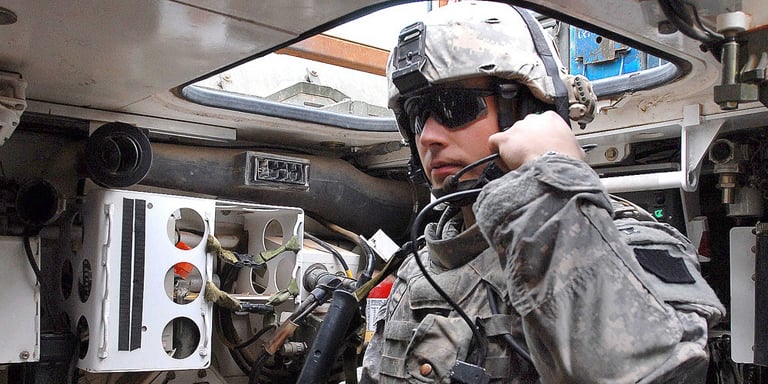
Clear, concise communication is essential to effective and (comparatively) safe convoy operations. There are many ways in which military personnel in a convoy communicate with one another, and you'll need to be familiar with all of them.
- Radio is the primary and preferred method of communication. However, unencrypted radio channels are vulnerable to enemy eavesdropping. Encrypted radio channels are more secure, but they have their own shortcomings, such as requiring specialized hardware that is less readily available and more prone to failure.
- Convoy vehicles can pass simple messages back and forth with light signals, either with handheld or vehicle-mounted lights. Morse code is always an option, but the enemy may know it. Alternatively, convoy commanders may choose to use custom signals for increased security.
- Hand and flag signals serve the same basic purpose as light signals, although they're less visible at night.
- Vehicle horns can be used for simple communication, although enemy forces in the area can generally hear loud sounds more easily than they can see visual signals.
- When all else fails, or when discretion and security are paramount, convoy vehicles can exchange handwritten messages, usually on simple signs.
Navigating Obstacles

When you're traveling in a military convoy, every obstacle you encounter is a potential danger — at worst, a potential ambush (more about reacting to ambushes in the next section).
Take bridges, for instance. Under normal circumstances, a bridge is just a bridge, but in a combat zone, it's an ideal ambush point. You probably have to cross it to reach your destination, and it could be wired with explosives or watched by snipers. Enemies may also use broken-down vehicles, felled trees or even crowds of people to block the road in order to force you to stop. These kinds of dangerous choke points are often called “fatal funnels.”
When it comes to dealing with obstacles, there's a simple order of operations that works in most cases.
- Clear the obstacle without stopping if you can. If it's a vehicle that you can simply push out of the way, then do so. If it's a pile of rocks or branches and your vehicle can handle driving over it, that's a good option, too. Honk the horn insistently and order civilians to clear the road immediately; if they don't, it may be an intentional obstruction.
- If you can't quickly and easily clear the obstacle, avoid it. Turn around without stopping and find another route. Be sure to mark the obstacle on your map and inform other vehicles via radio so they can find a good spot to turn around.
-
If you can neither clear nor avoid the obstacle, dismount and check it out on foot, carefully. Park the vehicle a good distance away but leave it running. Find cover and watch the obstacle and the surrounding area for as long as you can afford to. Tell your commander and other vehicles in the convoy what's going on. Classic signs of an ambush include:
- An obstacle that wasn't there the last time you passed through the area
- Large, unnatural-looking obstructions, such as a felled tree that's clearly been chopped down or that seems to have conveniently fallen in an unlikely spot
- Flashes of light that could be the sun reflecting off rifle scopes, particularly at positions higher than yours
- People (including children) paying unusually close attention to you or talking on radios or cell phones
Be sure to pay close attention to your surroundings and trust your instincts. Ask yourself: “If I were to set an ambush here, would I do it this way?” If the answer is “yes,” withdraw and find another route if at all possible.
Reacting to Ambushes
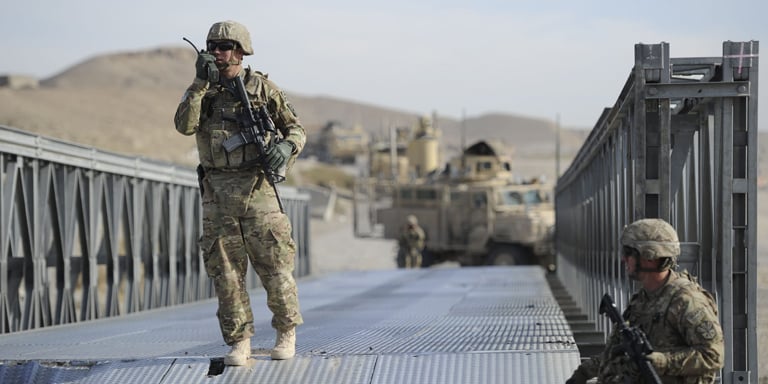
Attacks against convoys fall into one of two very broad categories: near and far ambushes. Each necessitates a different tactical response, but the general principles of surviving an ambush are usually the same.
- The most immediate goal is to keep the vehicles moving, or if they've been stopped, to get them moving again as quickly as possible. The enemy chose the location of the ambush precisely because it gives them a substantial advantage. As long as you're stuck in that spot, your odds of survival diminish every second, so you need to get out of the area right away.
- If you must engage the enemy before you can withdraw, do so with swift and overpowering force, to the extent that it's possible to do so under the circumstances. Try to put the enemy on the defensive, at least long enough to get moving again.
- Protect and evacuate wounded allies as quickly as you can. Don't render medical aid to your allies at the site of the ambush unless the injury is both life-threatening and potentially survivable with immediate treatment.
- Collect mission-critical equipment and intel before leaving, unless doing so is impossible.
- If you're ambushed, it's critical to do something — anything. Take action in an attempt to improve the situation in your favor. Call on fire support if you need to, and familiarize yourself with guerilla warfare tactics so you know how to combat them. Stagnation is death, and the longer you're pinned down, the shorter your list of options gets.
Near Ambush Tactics
A near ambush is one in which the aggressors are less than fifty meters away. Contrary to what Hollywood often shows in movies, near ambushes are less common than far ambushes because they are tactically advantageous for the attacker only in a fairly narrow range of situations.
The military trains you to charge the enemy in the event of a near ambush. If possible, charge for no more than 2-3 seconds at a time so that by the time the enemy lines up a shot on you, you're back in cover. Maximum aggression is crucial because, if you can't put the enemy on the defensive quickly, they will rapidly gain nearly total control of the situation.
Even with a proper and well-coordinated response by the defenders, near ambushes still generally favor the attackers. In such close quarters, your mobility is drastically limited and the enemy will almost surely have the advantage in terms of cover and vantage points. When defenders successfully repel the attack, it's usually done by engaging the enemy at close range and eliminating most or all of them.
Far Ambush Tactics
By contrast, a defender's best shot at surviving a far ambush (one in which the attackers are more than 50 meters away) is usually a tactical retreat. Attackers generally prefer to ambush from far away, especially in the wide-open desert environments of Iraq and Afghanistan.
Far ambushes are often more tactically sophisticated than near ambushes and require more advance planning. Attackers may utilize snipers, mines, tanks or mortars in an attempt to maximize damage to the defenders while minimizing their own susceptibility to counterattacks.
Because the attacker almost always has a significant advantage in terms of range, a charge by the defenders is usually ill-advised. But although the attackers' range may be an offensive advantage in some respects, it also makes it harder for them to limit the defenders' mobility. The best response to a far ambush is usually to regroup and get out of range as quickly as possible.
There's a lot to know about running a convoy safely and efficiently. If you're assigned to a convoy, you'll receive extensive training beforehand. Still, always keep these fundamental principles and tactics in mind. They may one day save your life, or a friend's.
Did you find this article helpful?



